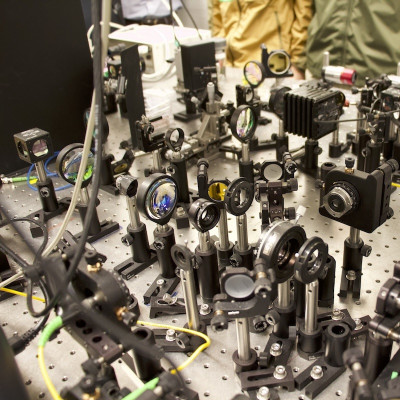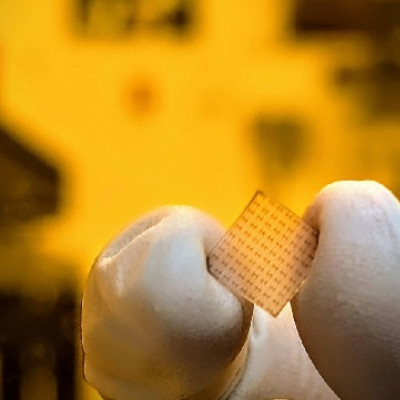Depending on the application, lasers differ in the way light is amplified and produced, which determines the colour of the radiation and the quality of the laser beam.
“Nanolasers are lasers that use structures a million times smaller than a millimetre to generate and amplify light, and the laser radiation is generated in an extremely tiny volume of material,” says Dr Mindaugas Juodėnas, one of the authors of the invention.
The laser’s operating principle resembles a hall of mirrors
Such nanolasers have been researched and developed for some time. However, KTU scientists’ version is unique in terms of its manufacturing process. It uses silver nanocubes, which are arranged neatly on a surface and filled with an optically active material. This creates the mechanism needed to amplify light and produce the laser effect.
“The silver nanocubes are extremely small, monocrystalline silver particles with excellent optical properties. It is an essential part of the nanolaser we have developed,” says Juodėnas, a researcher at the KTU Institute of Materials Science.
The nanocubes are synthesised using a unique process invented by KTU partners in Japan, ensuring their precise shape and quality. These nanocubes are then arranged into a two-dimensional structure using the nanoparticle self-assembly process.
During this process, the particles naturally arrange themselves from a liquid medium into a pre-patterned template.
When the template parameters match the optical properties of the nanocubes, a unique phenomenon called surface lattice resonance is created, allowing efficient light generation in an optically active medium.
While conventional lasers use mirrors to produce this phenomenon, the nanolaser invented by the KTU researchers uses a surface with nanoparticles instead. “When the silver nanocubes are arranged in a periodic pattern, light gets trapped between them. In a way, the process reminds a hall of mirrors in an amusement park, but in our case, the mirrors are the nanocubes and the visitor of the park is light,” explains Juodėnas.
International funding helped develop the idea
By using high-quality, easily produced nanomaterials such as silver nanocubes, the laser requires a record-low amount of energy to operate, allowing the lasers to be mass-produced.
“Chemically synthesised silver nanocubes can be produced in hundreds of millilitres, while their high quality allows us to use nanoparticle self-assembly technology. Even if their arrangement is not perfect, their properties make up for it,” says Juodėnas.
However, at the initial stages the simplicity of the method which should have attracted the interest, instead put Lithuanian research funding agencies off. “Sceptics questioned whether the simple method we were using would be able to create structures of high enough quality for a working nanolaser,” recalls professor Sigitas Tamulevičius.
Strongly believing in the quality of the nanolaser they were developing, the KTU Materials Science Institute team received funding from an international organisation, which, as Juodėnas says, assessed the idea as promising: “After a lot of work and a number of experiments, we have proved that even imperfect arrays can be effective if high-quality nanoparticles are used”.
A neat arrangement of nanoparticles, which is also used in another of KTU researchers’ inventions to create anti-counterfeiting marks, has already received international recognition and has been approved by the US and Japanese patent offices.
In the future, the nanolaser created by KTU researchers could be used as a light source in ultra-sensitive biological sensors for early detection of diseases or real-time monitoring of biological processes. It could also be applied in miniature photonic chips, identification technologies, and authentication devices, where the beam’s unique structure is crucial. Additionally, it could support fundamental research on how light interacts with matter on the nanoscale.
Read the original article on Kaunas University of Technology (KTU).







